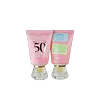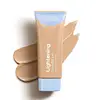What's inside
What's inside
 Key Ingredients
Key Ingredients

 Benefits
Benefits

 Concerns
Concerns

 Ingredients Side-by-side
Ingredients Side-by-side

Water
Skin ConditioningMethylene Bis-Benzotriazolyl Tetramethylbutylphenol
UV FilterDecyl Glucoside
CleansingPropylene Glycol
HumectantXanthan Gum
EmulsifyingEthylhexyl Triazone
UV AbsorberDicaprylyl Carbonate
EmollientGlycerin
HumectantCyclopentasiloxane
EmollientCyclohexasiloxane
EmollientOctyldodecanol
EmollientUndecane
EmollientTridecane
PerfumingSodium Hyaluronate
HumectantEthylhexylglycerin
Skin ConditioningGlyceryl Stearate
EmollientCeteareth-20
CleansingCeteareth-12
EmulsifyingCetearyl Alcohol
EmollientCetyl Palmitate
EmollientPropanediol
Solvent1,2-Hexanediol
Skin ConditioningPhenol
AntimicrobialTitanium Dioxide
Cosmetic ColorantTocopheryl Acetate
Antioxidant3-O-Ethyl Ascorbic Acid
Skin ConditioningSilica
AbrasivePhenoxyethanol
PreservativeTriethylene Glycol
MaskingWater, Methylene Bis-Benzotriazolyl Tetramethylbutylphenol, Decyl Glucoside, Propylene Glycol, Xanthan Gum, Ethylhexyl Triazone, Dicaprylyl Carbonate, Glycerin, Cyclopentasiloxane, Cyclohexasiloxane, Octyldodecanol, Undecane, Tridecane, Sodium Hyaluronate, Ethylhexylglycerin, Glyceryl Stearate, Ceteareth-20, Ceteareth-12, Cetearyl Alcohol, Cetyl Palmitate, Propanediol, 1,2-Hexanediol, Phenol, Titanium Dioxide, Tocopheryl Acetate, 3-O-Ethyl Ascorbic Acid, Silica, Phenoxyethanol, Triethylene Glycol
Water
Skin ConditioningEthylhexyl Methoxycinnamate
UV AbsorberCyclopentasiloxane
EmollientButylene Glycol
HumectantIsododecane
EmollientCaprylyl Methicone
Skin ConditioningNiacinamide
SmoothingDimethicone
EmollientEthylhexyl Palmitate
EmollientLauryl PEG-9 Polydimethylsiloxyethyl Dimethicone
Skin ConditioningPEG-10 Dimethicone
Skin ConditioningTitanium Dioxide
Cosmetic ColorantStearic Acid
CleansingDimethicone Crosspolymer
Emulsion StabilisingSodium Chloride
MaskingTriethylhexanoin
MaskingZinc Oxide
Cosmetic ColorantDisteardimonium Hectorite
StabilisingSilica
AbrasiveCyclohexasiloxane
EmollientPropylene Glycol
HumectantPolyhydroxystearic Acid
EmulsifyingPhenoxyethanol
PreservativeDimethicone/Vinyl Dimethicone Crosspolymer
Skin ConditioningAloe Barbadensis Leaf Extract
EmollientPropylene Carbonate
SolventTriethoxycaprylylsilane
Aluminum Hydroxide
EmollientNylon-12
Tocopheryl Acetate
AntioxidantGlycerin
HumectantAllantoin
Skin ConditioningAscorbyl Tetraisopalmitate
AntioxidantEthylhexylglycerin
Skin ConditioningDisodium EDTA
Sodium Hyaluronate
HumectantBHT
AntioxidantTrimethylsiloxysilicate
EmollientGlycyrrhiza Glabra Root Extract
BleachingCarbomer
Emulsion StabilisingPolysorbate 20
EmulsifyingPotassium Sorbate
PreservativeSodium Benzoate
MaskingTocopherol
AntioxidantPalmitoyl Pentapeptide-4
Skin ConditioningCI 77891
Cosmetic ColorantCI 77492
Cosmetic ColorantCI 77491
Cosmetic ColorantCI 77499
Cosmetic ColorantWater, Ethylhexyl Methoxycinnamate, Cyclopentasiloxane, Butylene Glycol, Isododecane, Caprylyl Methicone, Niacinamide, Dimethicone, Ethylhexyl Palmitate, Lauryl PEG-9 Polydimethylsiloxyethyl Dimethicone, PEG-10 Dimethicone, Titanium Dioxide, Stearic Acid, Dimethicone Crosspolymer, Sodium Chloride, Triethylhexanoin, Zinc Oxide, Disteardimonium Hectorite, Silica, Cyclohexasiloxane, Propylene Glycol, Polyhydroxystearic Acid, Phenoxyethanol, Dimethicone/Vinyl Dimethicone Crosspolymer, Aloe Barbadensis Leaf Extract, Propylene Carbonate, Triethoxycaprylylsilane, Aluminum Hydroxide, Nylon-12, Tocopheryl Acetate, Glycerin, Allantoin, Ascorbyl Tetraisopalmitate, Ethylhexylglycerin, Disodium EDTA, Sodium Hyaluronate, BHT, Trimethylsiloxysilicate, Glycyrrhiza Glabra Root Extract, Carbomer, Polysorbate 20, Potassium Sorbate, Sodium Benzoate, Tocopherol, Palmitoyl Pentapeptide-4, CI 77891, CI 77492, CI 77491, CI 77499
Ingredients Explained
These ingredients are found in both products.
Ingredients higher up in an ingredient list are typically present in a larger amount.
Cyclohexasiloxane is a type of silicone more commonly known as D6. It is an emollient and solvent.
Cyclohexasiloxane is used to evenly distribute ingredients throughout the product. When applied to the skin, Cyclohexasiloxane evaporates and leaves behind a silky feel.
As an emollient, it can help the skin feel soft and hydrated. It is also used to reduce frizz in hair products.
Learn more about CyclohexasiloxaneCyclopentasiloxane, or D5, is a silicone used to improve texture of products and trap moisture.
D5 is considered lightweight and volatile. Volatile means it evaporates quickly after application. Once evaporated, D5 leaves a thin barrier that helps keep skin hydrated.
It is also an emollient. Emollients help soften the skin and prevent water loss. Silicones create a silky texture in products. D5 helps other ingredients become more spreadable.
Studies show D5 is safe to use in skincare products. We recommend speaking with a skincare professional if you have concerns.
Learn more about CyclopentasiloxaneEthylhexylglycerin (we can't pronounce this either) is commonly used as a preservative and skin softener. It is derived from glyceryl.
You might see Ethylhexylglycerin often paired with other preservatives such as phenoxyethanol. Ethylhexylglycerin has been found to increase the effectiveness of these other preservatives.
Glycerin is already naturally found in your skin. It helps moisturize and protect your skin.
A study from 2016 found glycerin to be more effective as a humectant than AHAs and hyaluronic acid.
As a humectant, it helps the skin stay hydrated by pulling moisture to your skin. The low molecular weight of glycerin allows it to pull moisture into the deeper layers of your skin.
Hydrated skin improves your skin barrier; Your skin barrier helps protect against irritants and bacteria.
Glycerin has also been found to have antimicrobial and antiviral properties. Due to these properties, glycerin is often used in wound and burn treatments.
In cosmetics, glycerin is usually derived from plants such as soybean or palm. However, it can also be sourced from animals, such as tallow or animal fat.
This ingredient is organic, colorless, odorless, and non-toxic.
Glycerin is the name for this ingredient in American English. British English uses Glycerol/Glycerine.
Learn more about GlycerinPhenoxyethanol is a preservative that has germicide, antimicrobial, and aromatic properties. Studies show that phenoxyethanol can prevent microbial growth. By itself, it has a scent that is similar to that of a rose.
It's often used in formulations along with Caprylyl Glycol to preserve the shelf life of products.
Propylene Glycol is an odorless, colorless liquid. As a humectant, it helps skin retain moisture. It also aids in delivering active ingredients.
Another role of this ingredient is preventing a product from melting or freezing. Propylene glycol also adds antimicrobrial properties to a product, elongating product lifespan.
This ingredient is considered an organic alcohol and commonly added into both cosmetics and foods.
Those with sensitive skin or conditions may develop a rash when using this ingredient.
Learn more about Propylene GlycolSilica, also known as silicon dioxide, is a naturally occurring mineral. It is used as a fine, spherical, and porous powder in cosmetics.
Though it has exfoliant properties, the function of silica varies depending on the product.
The unique structure of silica enhances the spreadability and adds smoothness, making it a great texture enhancer.
It is also used as an active carrier, emulsifier, and mattifier due to its ability to absorb excess oil.
In some products, tiny microneedles called spicules are made from silica or hydrolyzed sponge. When you rub them in, they lightly polish away dead skin layers and enhance the penetration of active ingredients.
Learn more about SilicaSodium Hyaluronate is hyaluronic acid's salt form. It is commonly derived from the sodium salt of hyaluronic acid.
Like hyaluronic acid, it is great at holding water and acts as a humectant. This makes it a great skin hydrating ingredient.
Sodium Hyaluronate is naturally occurring in our bodies and is mostly found in eye fluid and joints.
These are some other common types of Hyaluronic Acid:
Learn more about Sodium HyaluronateTitanium dioxide is a mineral UV filter widely used in sunscreens and cosmetics.
It is one of only two UV filters officially classified as “mineral” by regulatory agencies, the other being zinc oxide.
Titanium dioxide provides broad-spectrum protection mostly in the UVB and UVAII range, with some protection in the UVAI range.
While its UVA protection isn’t as strong as zinc oxide’s, the difference is minor.
A common myth is that mineral UV filters reflect UV light. However, modern research shows titanium dioxide absorbs UV radiation like chemical filters (~95% absorption & 5% reflection).
Thanks to its non-irritating nature, titanium dioxide is suitable for sensitive, acne-prone, or redness-prone skin. It is unlikely to cause "eye sting" like other sunscreen ingredients.
A major drawback of this ingredient is its white cast and thick texture. This is why mineral sunscreens often leave a white cast and are less cosmetically elegant than chemical/hybrid sunscreens.
To improve white cast and spreadability, micronized or nano-sized titanium dioxide is often used.
There are ongoing concerns surrounding nano-titanium oxide's impact on marine ecosystems.
There is no conclusive evidence that any form of titanium oxide (or any other sunscreen ingredients) will cause harm to marine ecosystems or coral reefs. The science is still developing but many consumers are keeping a close eye on this issue.
Please note, many destinations have reef-safety sunscreen rules. For instance, the U.S. Virgin Islands advises all visitors to use non-nano mineral sunscreens.
Nano mineral sunscreens once raised safety concerns about absorption into skin.
Extensive research has shown that they do not penetrate healthy or damaged skin; they remain safely on the surface and the top layer of dead skin (stratum corneum).
You'll likely find titanium dioxide bundled with alumina, silica, or dimethicone. These ingredients help make titanium dioxide highly photostable; this prevents it from interacting with other formula components under UV light.
Learn more about Titanium DioxideTocopheryl Acetate is AKA Vitamin E. It is an antioxidant and protects your skin from free radicals. Free radicals damage the skin by breaking down collagen.
One study found using Tocopheryl Acetate with Vitamin C decreased the number of sunburned cells.
Tocopheryl Acetate is commonly found in both skincare and dietary supplements.
Learn more about Tocopheryl AcetateWater. It's the most common cosmetic ingredient of all. You'll usually see it at the top of ingredient lists, meaning that it makes up the largest part of the product.
So why is it so popular? Water most often acts as a solvent - this means that it helps dissolve other ingredients into the formulation.
You'll also recognize water as that liquid we all need to stay alive. If you see this, drink a glass of water. Stay hydrated!
Learn more about Water